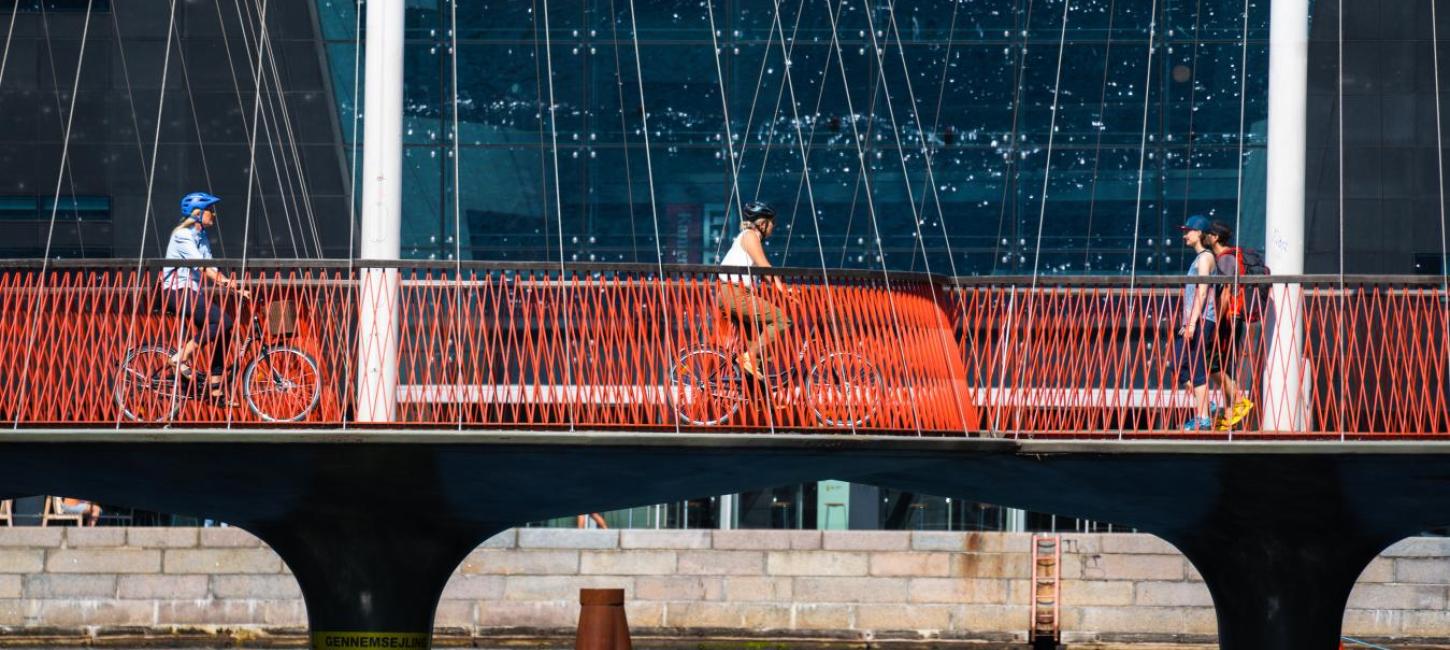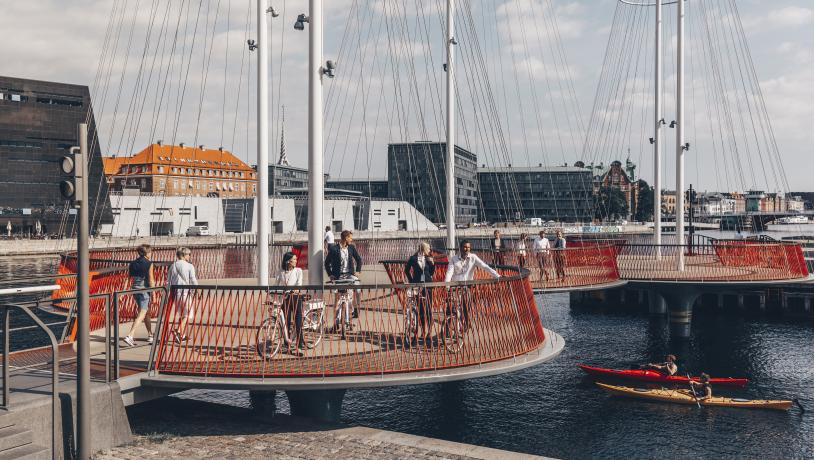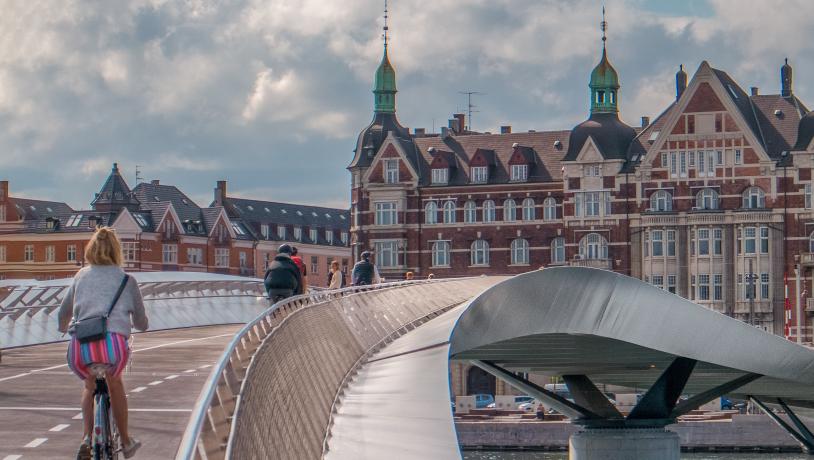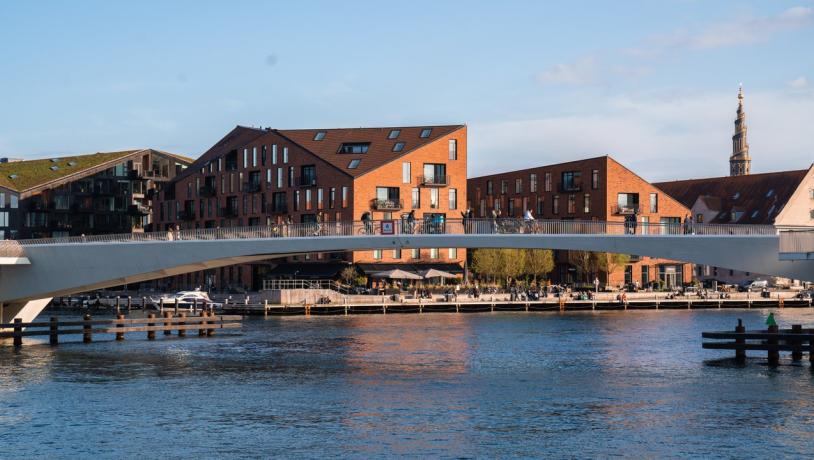Copenhagen is UNESCO-UIA World Capital of Architecture until 2026
Copenhagen manages a one-year programme with a focus on the future of architecture. Discover the city’s unique approach to citizen-centric urban desig...

A cycling city doesn’t build itself. Some serious thinking by architects shaped Copenhagen into one of the world’s most bike-friendly cities. How did they do it? They created bike parking to wide cycle lanes and car-free bike bridges, to make sure the cyclist’s needs are prioritised.
Bicycle architecture and mobility are essential in Copenhagen, where bikes outnumber cars by more than five to one and commuters usually prefer to cycle rather than drive. The volume of bikes steering their way through the city’s streets during commuter hours is often surprising to visitors; half the trips to work and school in the city are taken by bike, whether that’s a road bike, a laden-down cargo bike, a kid’s bike, or an e-bike. As well as outnumbering cars, bikes in Copenhagen outnumber people. For visitors, cycling is a great way to explore the capital and experience local culture at the same time.
The city’s strategy around bicycle architecture – architecture that makes cycling more fun and feasible – is around providing creative design solutions that function well, thereby promoting a healthy lifestyle, making Copenhagen the world's most bicycle-friendly capital. In practical terms, that includes building-wide bike lanes separated from the main traffic by a curb so everyone can cycle safely, considering bike parking spaces in urban design, and building innovative and iconic bridges that accommodate bike traffic. These bridges are a key transit route for cyclists in the city, allowing them to easily navigate between the different districts, with typically a beautiful view of the harbour and harbour living as they go. Built deliberately to open and connect the city, they demonstrate Copenhagen’s focus on integrating and promoting everyday bike usage and showcase an important part of what makes Copenhagen World Capital of Architecture in 2023.
In the case of the areas included on the recreational 13km path of The Harbour Circle, these bridges have also turned lesser-known areas like Sluseholmen among other harbourfront areas into a destination in themselves, opening views of city living to visitors that one might not otherwise come across. The city’s newest bike bridge, Lille Langebro, was opened in 2019 as an alternative to the heavily trafficked Langebro and brings together the contemporary harbourfront around BLOX and the Danish Architecture Center with the historic harbourside in Christianshavn, building stronger connections that allow the latter to feel more accessible from the heart of the city and vice versa.
Following the focus on cycling in Copenhagen, also after hosting the Tour de France’s Grand Depart in July 2022, the Danish Minister of Transportation announced a 10 million Euro investment in further maintaining and improving cycling infrastructure in the city, so the city continues to develop its position as the world’s leading cycling city.
Take a look at how Copenhagen has used architecture to improve connectivity between different city districts and boost the use of bike bridges in the world’s most bike-friendly place.

Photo:Martin Heiberg
Completed: 2015 by the architects Olafur Eliasson.
This five-masted bridge stands out from the crowd. Built with five circular platforms, the masts refer back to the area’s maritime past and was partly inspired by the designer’s childhood days in Iceland, where he imagined walking from boat to boat across the local harbour. The bridge was designed as a celebration of pedestrians, a place where they could meet, stop and enjoy harbour views, and take a breath. The zigzag shape of the path is designed to make people reduce their speed, whether they are walking or cycling. It’s more than a bridge: it’s also a meeting place and a viewing platform, and a location for introspection on the busy harbourfront.
When large ships want to pass by, two of its discs swing open like a gate, allowing them through and opening up access to this part of the Christianshavn canal system with the most beautiful flourish. For more information read here.

Photo:Giuseppe Liverino
Completed: 2019 by the architects Wilkinson Eyre Arkitekter.
Over 300 years ago, this was the location of the very first Langebro bridge; today it’s the city’s newest cycling and pedestrian bridge and part of BLOX, a contemporary harbourside area. The 160-metre bridge connects one of Copenhagen’s most picturesque neighbourhoods, Christianshavn, and the city centre with an elegant modern design, using a curved shape to align with the ramparts and moat of this historic area. The swing bridge has ‘wings’ that open in the middle to allow boats through, with a concealed mechanism for an uninterrupted flow. The contrast between the colours of the bridge – off-white, dark grey and stainless steel – allows it to appear as a twisting ribbon across the water. For cyclists and pedestrians, this bridge offers a great alternative to its traffic-heavy big brother, Langebro. For more information read here.

Photo:VisitCopenhagen
Completed: 2017 by the architects C. F. Møller.
This award-winning state-of-the-art medical research building in Copenhagen’s hip Nørrebro district has a zigzagging floating cycle and pedestrian path around it allowing access for the public and connecting the campus with the nearby streets. It’s designed particularly to create flow around the building and invite the public in. The undulating and steep path is not built for speed; it’s a meandering route that follows the organic shape of the building, offering new views of the nearby green spaces and city rooves from the top. It’s designed to open new horizons and interlink the local area in an intriguing and intimate way. Insider tip: Park your bike in the basement and visit the buildings’ 15th floor for some amazing views of the city! The tower is open to the public during weekdays until 5 pm. For more information read here.

Photo:Visit Copenhagen
Completed: 2016 by the architects Dissing+Weitling.
This elegant and curvaceous orange bike bridge and cycle path remove the need for cyclists to hump their bikes up and down stairs when travelling from the Dybbelsbrø area to the harbourside. An elevated road just for cyclists, it swoops and winds its way down seven metres from the upper street to the lower street, controlling bike speed with curves as it descends and producing a fun riding experience as a result. It connects with another bike bridge across the harbour, Bryggebroen, making cycling in this area seamless, efficient and fun. For more information read here.

Photo:Daniel Rasmussen
Completed: 2011 by the architects Studio Bednarski Limited / DFA.
Connecting Nyhavn with Christianshavn, this bridge is nicknamed ‘The Kissing Bridge’ because it is fully retractable - the two parts of the bridge join in a kiss. It’s Europe’s first retractable bridge and supports at least 16,000 cyclists as they cross the harbour daily. Look out for views of the Royal Danish Opera House, The Royal Danish Playhouse and harbourside life as you cross. For more information read here.
Completed: 2018 by the architects Cobe.
This bridge in the south of Copenhagen is part of the Harbour Circle, a 13-km cycling route around the inner harbour, and is notable for its 70m-long wooden bench, positioned with a view of houseboats and harbour life. The long bench was designed to encourage people to stop and enjoy the view, showing how design can change a space you might typically transit through into a place where you are able to linger and enjoy. It echoes the way locals use Dronning Louises Bro by the lakes in the west of the city as a place to meet and enjoy in the evening. The bowed shape of the bench reflects the shape of the waves in the harbour below. For more information read here.
Download a selection of pictures related to bike-friendly architecture in Copenhagen. Press photos - Bike-friendly architecture in Copenhagen. The photographer must be credited.

Senior Manager – Press & PR